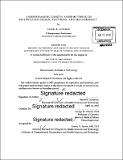| dc.contributor.advisor | George M. Church. | en_US |
| dc.contributor.author | Goodman, Daniel B. (Daniel Bryan) | en_US |
| dc.contributor.other | Harvard--MIT Program in Health Sciences and Technology. | en_US |
| dc.date.accessioned | 2016-09-30T19:38:30Z | |
| dc.date.available | 2016-09-30T19:38:30Z | |
| dc.date.copyright | 2016 | en_US |
| dc.date.issued | 2016 | en_US |
| dc.identifier.uri | http://hdl.handle.net/1721.1/104615 | |
| dc.description | Thesis: Ph. D. in Bioinformatics and Integrative Genomics, Harvard-MIT Program in Health Sciences and Technology, 2016. | en_US |
| dc.description | Cataloged from PDF version of thesis. | en_US |
| dc.description | Includes bibliographical references (pages 149-158). | en_US |
| dc.description.abstract | Next-generation DNA sequencing has allowed us to extract vast quantities of functional information from genetic systems. However, natural systems represent only a fraction of all possible DNA sequences. Our understanding of how genomes function is limited by our ability to make modifications and test hypotheses. Multiplexed DNA synthesis now allows us to generate thousands of computationally designed sequences, each representing a physical hypothesis to test. Here, we combine DNA sequencing and synthesis technologies to design, make, and measure the behavior of thousands of new genetic elements in the bacterium E. coli. We begin by quantifying the interactions between regulatory elements that control transcription and translation and show that these interactions create large deviations from the predicted behavior of individual elements. Regulatory elements also interact with the codons of the genes they control. We show that rare codon usage at the beginning of genes unexpectedly leads to a strong increase in protein translation due to the relationship between codon rarity, genomic nucleotide bias, and mRNA structure. We next examine the behavior of regulatory elements that bind transcription factors by designing and synthesizing over 100,000 transcriptional circuits. From each circuit we measure repression, activation, and small-molecule induction, deriving relationships between DNA sequence features and functional properties including cooperativity, sensitivity, and dynamic range of gene expression response. Finally, as the scale and speed of DNA synthesis and functional readout continues to increase, our ability to computationally design and analyze genetic systems has become the bottleneck. We have built software to predict and design individual genetic elements in high throughput (Promuter) as well as software to analyze and compare hundreds of evolved or engineered bacterial whole genomes (Millstone). As generating high dimensional datasets becomes exponentially easier than designing experiments and extracting knowledge, bioinformatics, machine learning, and data science will become the primary tools we use to pose new hypotheses and build models of biology. | en_US |
| dc.description.statementofresponsibility | by Daniel B. Goodman. | en_US |
| dc.format.extent | 158 pages | en_US |
| dc.language.iso | eng | en_US |
| dc.publisher | Massachusetts Institute of Technology | en_US |
| dc.rights | M.I.T. theses are protected by copyright. They may be viewed from this source for any purpose, but reproduction or distribution in any format is prohibited without written permission. See provided URL for inquiries about permission. | en_US |
| dc.rights.uri | http://dspace.mit.edu/handle/1721.1/7582 | en_US |
| dc.subject | Harvard--MIT Program in Health Sciences and Technology. | en_US |
| dc.title | Understanding genetic systems through multiplexed design, synthesis, and measurement | en_US |
| dc.type | Thesis | en_US |
| dc.description.degree | Ph. D. in Bioinformatics and Integrative Genomics | en_US |
| dc.contributor.department | Harvard University--MIT Division of Health Sciences and Technology | |
| dc.identifier.oclc | 959007331 | en_US |
